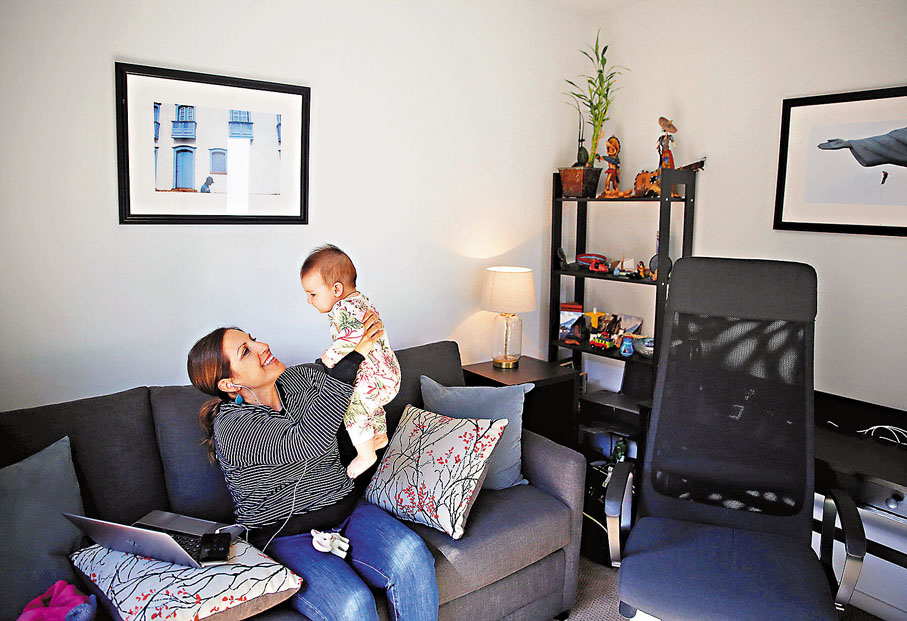
【原文】下文摘錄自香港《文匯報》10月4日︰
在新冠疫情下,居家工作(work from home)成為常態(norm),現時隨着部分地區的疫情趨緩,應否返回工作場所上班,還是維持在家工作模式,引發不少爭議(controversy)。許多僱主認為員工需面對面溝通,才有助交流及發揮創意,不過對許多僱員而言,這段期間已適應在家工作的彈性(flexibility),甚至有員工接受僱主減薪要求,也要維持現有工作模式。
科技企業是最先推行在家工作的行業之一,不過至今遲遲未能恢復員工重返辦公室工作,以美國大型科企微軟(Microsoft)為例,便要將員工重回辦公室的日子推遲至10月,蘋果公司(Apple)、Google、facebook等公司更推遲至明年,企業軟件服務商Salesforce人力資源主管海德(Brent Hyder)便慨嘆,原以為遙距工作(remote working)會是他職業生涯中最艱難的1年半,但事實證明要重回原本工作模式更困難。
不過對不少科企而言,管理層一直相信員工應在實體空間聚頭,互相交換意見,才能激發創新思維(innovative thinking),在家獨自工作便無法做到這點,甚至不少科企巨擘不惜斥資數億美元,打造更舒適、更大公共空間的新辦公室,希望吸引員工返回辦公地點。其中亞馬遜(Amazon)、蘋果等公司便已表明,期望員工每周有最少數日回到辦公室工作。
Adobe人力資源主任格洛里亞·陳(譯音)(Gloria Chen)亦解釋,僱主期望提升員工士氣(morale),並將工作與家居環境分開,是企業希望回復辦公室工作的最大因素,她形容員工在家工作不會完全取消,不過仍然堅持員工聚首工作、彼此交流互動的重要性。
有專家則不認同這些僱主的說法,如科企公關公司EZPR自2012年成立以來,一直以遙距工作模式運作,創辦人西特龍(Ed Zitron)直指重回辦公室的唯一原因,是滿足高層可以見到員工聚集,「從而享受權力的感覺」;商用軟件公司Twilio的人力資源主任萊克(Christy Lake)同樣認為,透過聚集帶來創新的概念已經過時(outdated),甚至沒有數據支持此說法。
不少僱員在過往一年多的疫情期間,已適應在家工作模式,他們普遍認為在工作日可有較大彈性,毋須花費大量時間在上下班交通上,也有較多時間在家中照顧子女。美國市場研究公司GoodHire在8月份公布的研究便顯示,61%受訪者願意接受減薪(pay cut),以維持在家工作,70%受訪者願意為此放棄醫療保障、有薪假期(paid leave)等福利,甚至有45%受訪者指如果被迫重回辦公室,便會馬上辭職或尋找下一份工作。
部分企業堅持員工需重返辦公室,例如Google便向僱員提出,如果選擇長期在家工作,將被減薪25%。雲端通訊企業Twilio等公司則採用混合模式(hybrid model),容許僱員自己選擇回到辦公室工作的頻率,三藩市「灣區委員會」(San Francisco Bay Area Committee)表示,在新冠疫情爆發前訪問逾200間公司,當中70%要求員工須在辦公室工作,到了今年7月中的同類調查,近2/3企業預期員工每周返回辦公室工作兩三天。
哥倫比亞大學(Columbia University)經濟學助理教授布德羅(Laura Boudreau)解釋稱,疫情持續愈久,僱主便愈難要求僱員重回辦公室,原因是僱員大多已習慣居家工作模式,尤其科企不少工作其實都可遙距進行,在社會不再將遙距工作視為暫時性的情況下,僱主和僱員有需要在工作條件方面尋求平衡,避免引發不必要的爭拗(dispute)。
New normal of work from home turns working into employee-employer wrestling
【譯文】Working from home has become the new norm under the pandemic. Since the situation is subsiding, there is controversy on whether employees should return to work as normal or maintain the work-from-home mode. Many employers believed that employees do need to interact face-to-face to facilitate exchange of ideas and boost creativity, where as most employees have already adapted to the flexibility of working from home, and some even took a pay cut as requested by their employers in order to maintain the current working model.
Information technology enterprises are one of the first industries to implement work-from-home policy, but their employees have still not yet been able to return to their workplace. For example, the large U.S. technical company Microsoft would need to postpone the date for its employees to return to work to October, while others such Apple, Google, facebook etc. even deferred it to next year. Brent Hyder, Chief People Office of the enterprise software company Salesforce, originally thought that remote working was the most difficult year and a half in his career, but it turned out that it was even more challenging to go back to the original working mode.
Yet, for many companies, the top management has always believed that employees should mingle together in physical space to facilitate exchange of ideas and stimulate innovative thinking, which could not be achieved by working from home. Some technology giants even spent hundreds of millions of dollars to create new office space with more comfortable and larger common area, hoping to attract employees to return to work, and some such as Amazon and Apple have explicitly said that they would expect employees to return to office for a certain number of days per week.
Gloria Chen, Chief People Officer of Adobe, also explained that employers' desire to boost the morale of employees and separate working and home environment is the most important factor that enterprises want to resume normal working model. She added that work-from-home policy would not be completely cancelled, but insisted on the importance of working and interacting with each other.
However, some experts do not agree with these comments. For example, the public relations firm EZPR has been operating in a remote working mode since its establishment in 2012, and the founder Ed Zitron said that executives wanted to have people back in the office simply because they wanted to feel powerful seeing staff gathering together. Christy Lake, Chief People Officer of the commercial software firm Twilio, also believed that the concept of bringing innovation through gathering has been outdated without any data to support the claim.
Many people have adapted to working from home over the last year amidst the pandemic. They generally believe that they would enjoy greater flexibility, save the time traveling back and forth between workplace and their home, and can spend more time taking care of their children. According to the statistics published by the American market research company GoodHire in August, 61% of respondents were willing to accept a pay cut to maintain the work-from-home mode, and 70% were willing to give up medical benefits and paid leaves etc., while 45% even said that they would immediately quit and look for another job if they were required to go back to office.
Some companies insist that employees do need to return to office. For instance, Google proposed a salary cut of 25% for staff who opted to work from home. Other companies such as the cloud communications firm Twilio adopted a hybrid model, allowing staff to decide on the frequency of returning to office. The San Francisco Bay Area Committee said that it had interviewed over 200 firms before the pandemic outbreak, among which 70% of them required employees to work on-site, while a similar survey conducted in mid-July this year indicated that almost two thirds of the enterprises would expect their employees to return to office for two to three days per week.
Columbia University assistant economics professor Laura Boudreau said that as the pandemic persists, it would be more difficult for employers to ask employees to return to an in-person office environment, as they have already adapted to remote working, particularly this has been widely practiced among IT enterprises. Against this backdrop, remote working is no longer considered as a temporary arrangement by society, and it would be important for employers and employees to strike a balance concerning working conditions to avoid unnecessary disputes.●龐嘉儀
Q&A
1. 研究還顯示有多少美國僱員會為遙距辦公選擇而留任目前工作?
2. 研究還顯示有多少美國僱員願意為遙距辦公選擇而移居新城市?
3. Google曾有調查顯示只有多少員工希望每天到回到辦公室?
4. 現時美國有超過多少名僱員已實行Home Office?
5. 有哪些科企已計劃在日後提供遙距辦公選擇?
Answer
1. 74%
2. 60%
3. 8%
4. 400萬
5. Google、facebook、Twitter、Reddit等






0 / 255